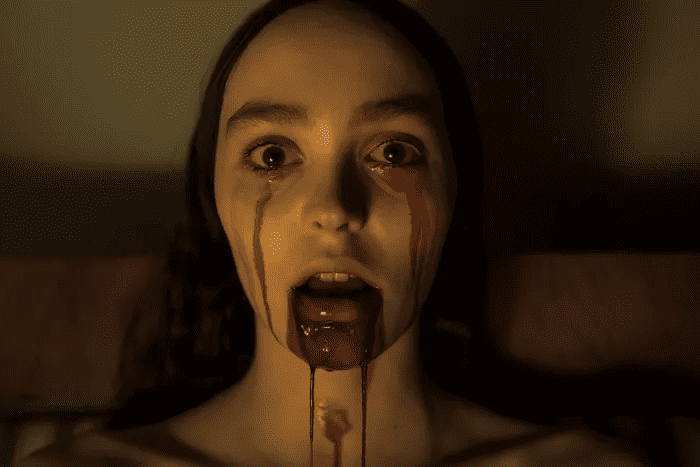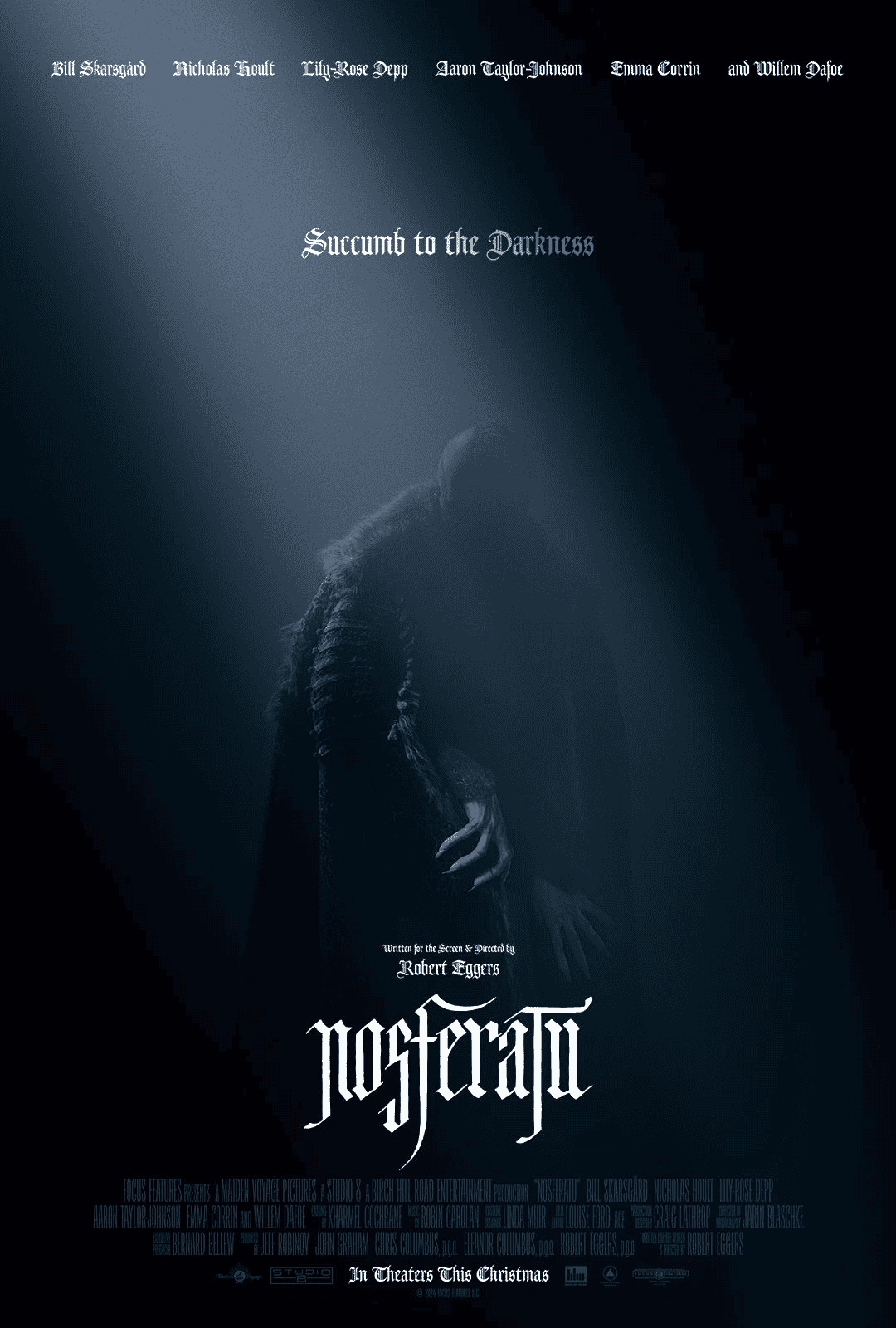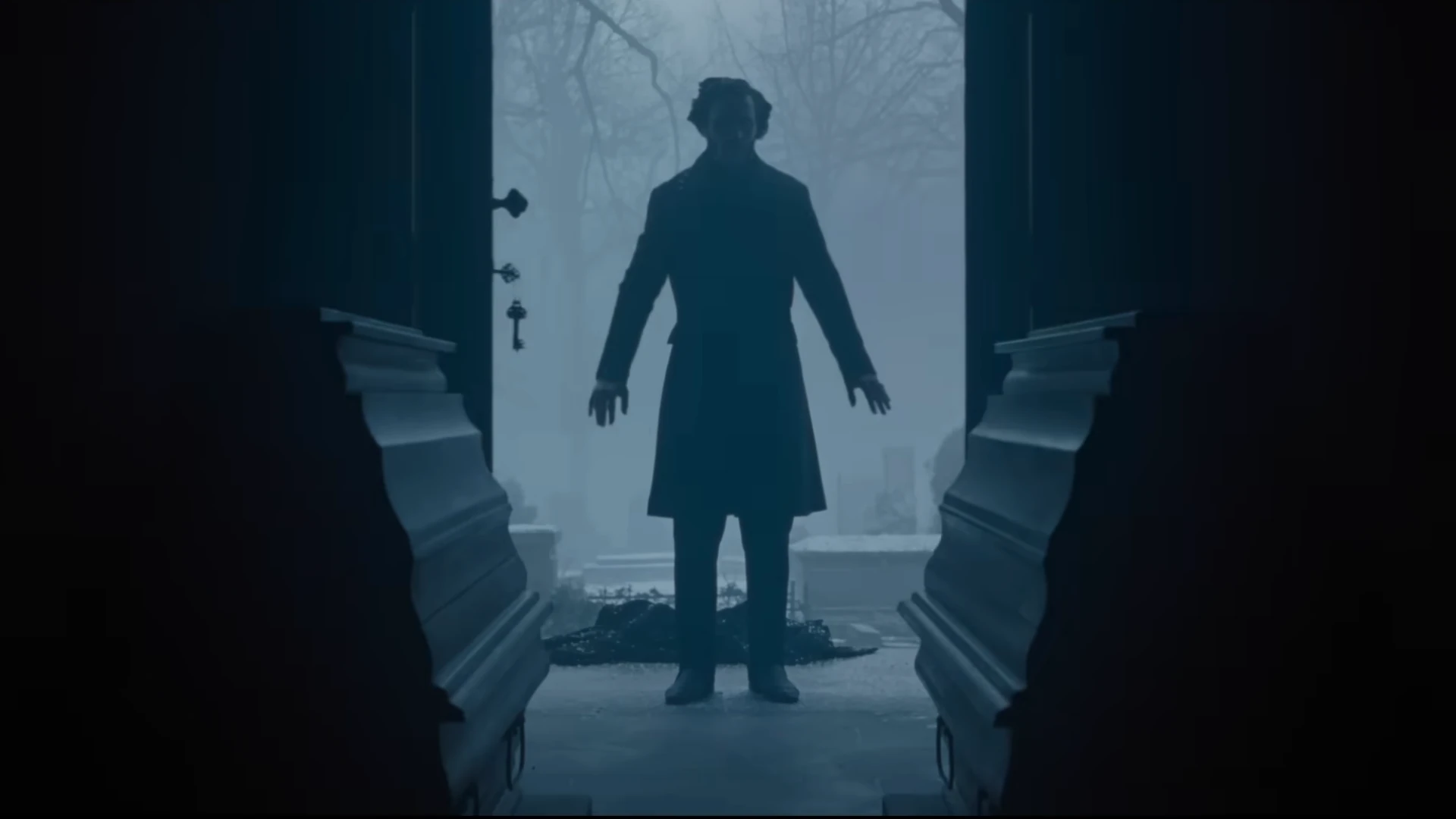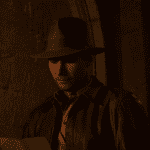Robert Eggers’ “Nosferatu” (2024) breathes new life into the classic vampire tale. This gothic horror film captivates audiences with its chilling atmosphere and haunting visuals. Critics praise Eggers’ adaptation as a masterpiece that honors the original while adding fresh, terrifying elements.
The movie reimagines F.W. Murnau’s 1922 silent film, updating the story for modern viewers. Bill Skarsgard plays Count Orlok, delivering a performance that is both unsettling and mesmerizing. His portrayal of the vampire blends otherworldly menace with a hint of tragic loneliness.
Eggers’ attention to period detail and atmospheric cinematography creates a sense of dread that permeates every frame. The film’s use of shadow and light pays homage to its expressionist roots while employing contemporary filmmaking techniques. This blend of old and new results in a uniquely immersive horror experience.
Robert Eggers’ Nosferatu: A Modern Horror Triumph

A New Take on a Classic Tale
Robert Eggers’ new movie, Nosferatu, is out now. It’s a remake of the famous 1922 silent film. People who have seen it are saying great things. Many call it a masterpiece of gothic horror.
What the Reviews Say
Critics really like the movie. They praise its dark and spooky atmosphere. They also love the acting. Bill Skarsgård plays Count Orlok, the vampire. People say his performance is terrifying. Lily-Rose Depp plays Ellen Hutter. She also gets a lot of praise for her acting.

Atmosphere and Visuals
Eggers is known for making movies that look amazing. Nosferatu is no different. The movie is full of dark shadows and creepy settings. It really makes you feel like you’re in a scary old world. The film has a very distinct style, with some shots resembling classic paintings.
Focus on the Monster
This version of Nosferatu focuses on the scary parts of the story. It shows how Orlok is a true monster. It doesn’t try to make him seem romantic or cool. This makes the movie even more frightening.
Key Elements Praised by Critics
Here’s a list of things critics liked:
- The spooky atmosphere
- The great acting, especially by Skarsgård and Depp
- The beautiful and creepy visuals
- The focus on the scary parts of the story
The Ending
The ending is a big talking point. It’s dark and sad, but also beautiful in a strange way. It leaves a lasting impression on viewers.
A Must-See for Horror Fans
If you like horror movies, especially gothic horror, you should definitely check out Nosferatu. It sounds like a movie that will stay with you long after you see it.
Key Aspects of the Film’s Reception
| Aspect | Description |
|---|---|
| Overall Reception | Overwhelmingly positive; called a masterpiece |
| Atmosphere | Dark, spooky, and immersive |
| Performances | Highly praised, especially Skarsgård and Depp |
| Visuals | Stunning, resembling classic paintings |
| Focus | Emphasis on the monstrous nature of Orlok |
| Ending | Bleak, beautiful, and memorable |
Key Takeaways
- Eggers’ “Nosferatu” updates a classic vampire story with fresh terror
- Critics hail the film as a visually stunning gothic horror masterpiece
- Bill Skarsgard’s Count Orlok delivers a chilling and captivating performance
Cinematic Reimagining of a Classic Horror
Robert Eggers’ 2024 adaptation of Nosferatu breathes new life into the iconic vampire tale. The film pays tribute to F.W. Murnau’s 1922 silent masterpiece while offering a fresh perspective on the legendary monster.
Homage to F.W. Murnau’s Nosferatu
Eggers’ version maintains strong ties to Murnau’s original film. The director carefully preserves key visual elements and plot points that made the 1922 movie a horror landmark. Count Orlok’s distinctive silhouette and long, curved fingernails remain intact, honoring the iconic imagery.
The new film also keeps the eerie atmosphere of its predecessor. Eggers uses shadow and light masterfully, creating tension through visual storytelling. This approach mirrors Murnau’s expressionist style, which relied heavily on contrast and unusual camera angles.
Fans of the original will spot numerous nods throughout the movie. These include recreations of famous scenes and subtle references to Murnau’s innovative techniques.
Evolution of the Nosferatu Legend
While respecting its roots, Eggers’ Nosferatu evolves the vampire mythos. The film expands on Count Orlok’s backstory, adding depth to the character without diminishing his menace. This approach gives viewers a more complex antagonist to fear and, perhaps, understand.
The movie also updates certain elements for modern audiences. It explores themes relevant to today’s society, such as isolation and the spread of disease. These additions make the century-old story feel surprisingly timely.
Eggers incorporates influences from other vampire tales, including Bram Stoker’s Dracula. This blending of sources creates a richer narrative tapestry, appealing to both horror aficionados and newcomers to the genre.
Aesthetic and Mood
Eggers and cinematographer Jarin Blaschke craft a visually stunning film. They use a muted color palette that evokes the feel of early 20th-century photography. This choice helps immerse viewers in the period setting.
The movie’s production design meticulously recreates 1830s Germany. Detailed costumes and sets transport the audience to a bygone era. This attention to historical accuracy enhances the film’s authenticity and atmosphere.
A haunting score amplifies the sense of dread throughout the movie. The music blends period-appropriate instruments with modern composition techniques. This creates a soundscape that is both familiar and unsettling, perfectly complementing the on-screen action.
Creative Endeavors and Critical Acclaim
Robert Eggers’ “Nosferatu” (2024) showcases the director’s artistic vision and the cast’s powerful performances. Critics praise the film’s atmospheric horror and nuanced character portrayals.
Robert Eggers’ Directorial Precision
Eggers brings his signature style to “Nosferatu,” building on his success with “The Witch,” “The Lighthouse,” and “The Northman.” His attention to historical detail creates a vivid, archaic world where vampirism feels chillingly plausible. The director’s focus on period accuracy grounds the supernatural elements in a tangible reality.
Eggers merges fear and desire, infusing the classic tale with heightened sexuality. His approach to gothic horror challenges conventions, delivering a fresh take on the vampire myth. The film’s visual style emphasizes shadow and light, creating a haunting atmosphere that pays homage to its silent film predecessor.
Acting Performances
The cast of “Nosferatu” delivers compelling portrayals that bring depth to the characters. Lily-Rose Depp stands out as the haunted young woman at the center of the story. Her performance captures the character’s internal struggle and growing obsession.
Nicholas Hoult and Bill Skarsgård bring intensity to their roles, with Skarsgård’s portrayal of the vampire drawing particular praise. Willem Dafoe’s appearance adds gravitas to the ensemble. Critics note the chemistry between the actors, which heightens the film’s emotional impact.
The performances blend subtlety and intensity, matching Eggers’ directorial vision. Each actor contributes to the film’s atmosphere of dread and psychological horror.
Frequently Asked Questions
Robert Eggers’ “Nosferatu” (2024) has sparked curiosity and discussions among film enthusiasts. The movie’s unique approach to the classic vampire tale has led to several key questions.
What are the major themes explored in ‘Eggers’ Nosferatu’?
The film delves into themes of obsession and desire. It examines the blurred lines between fear and attraction.
The vampire’s infatuation with the young woman drives the narrative. This relationship serves as a metaphor for destructive love and forbidden longing.
How did ‘Eggers’ Nosferatu’ differentiate from previous adaptations?
Eggers’ version stands out with its historical accuracy. The film is set in a grimly realistic medieval world.
It portrays vampirism as a believable threat. This approach grounds the supernatural elements in a tangible, frightening reality.
The movie also infuses more sexuality into the story. This adds a layer of complexity to the characters’ motivations and relationships.
What filmmaking techniques were used to create the atmosphere in ‘Eggers’ Nosferatu’?
Eggers employed meticulous attention to period details. This creates an immersive historical setting.
The film uses stark visuals and haunting shadows. These elements pay homage to the original 1924 silent film.
Sound design plays a crucial role. It enhances the eerie atmosphere and builds tension throughout the movie.
Who are the primary cast members of ‘Eggers’ Nosferatu’ and how were their performances received?
Bill Skarsgård stars as the vampire Count Orlok. His performance has been praised for its menacing presence and otherworldly quality.
Lily-Rose Depp portrays the haunted young woman. Critics have commended her portrayal of vulnerability and growing obsession.
The supporting cast adds depth to the film’s world. Their performances contribute to the overall gothic atmosphere.
What are some of the standout set pieces or locations used in ‘Eggers’ Nosferatu’?
The film features meticulously crafted medieval towns. These locations transport viewers to a bygone era.
Gothic castles and dimly lit corridors create a sense of dread. They serve as perfect backdrops for the vampire’s lurking presence.
Natural landscapes play a significant role. Foggy forests and desolate mountainsides add to the film’s ominous tone.
How has ‘Eggers’ Nosferatu’ influenced the genre of Gothic horror in film?
Eggers’ adaptation has set a new standard for period horror. It shows how historical accuracy can enhance the genre’s impact.
The film’s success may inspire more thoughtful remakes of classic horror stories. It demonstrates the value of reimagining familiar tales with fresh perspectives.
“Nosferatu” (2024) blends art house sensibilities with horror elements. This approach may encourage more directors to take risks with genre films.







